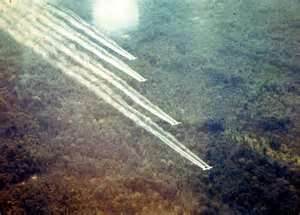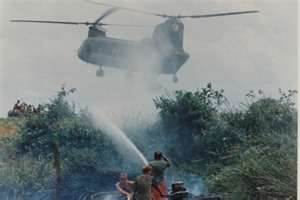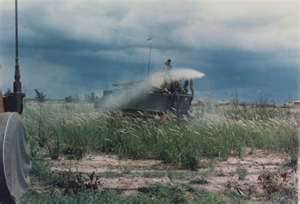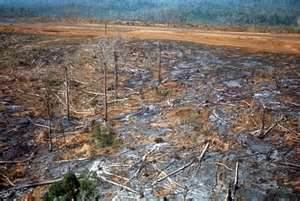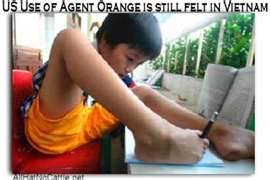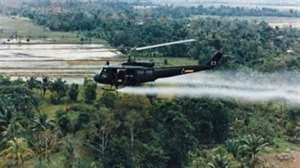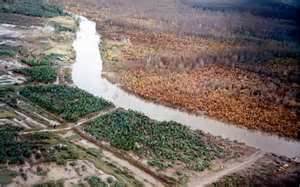
On 9 August 2012, it was announced that the United States and Vietnam's defense ministry had launched the first cleanup operation to rid what had been Da Nang Air Base of toxic dioxin left from the Vietnam war. The project aimed to clean up soil and sediment contaminated with dangerous levels of toxin dioxin. What had subsequently become Da Nang Airport had been used to store herbicides during the US counterinsurgency campaign in Vietnam. Da Nang Airport was the most toxic of 28 so-called dioxin "hot spots" in Vietnam. The $43 million project would excavate and clean up 73,000 cubic meters of soil and sediment around the airport. The soil and sediment would be heat treated to destroy or otherwise reduce the amount of dioxin to acceptable levels. The US embassy said at the time that the soil should be safe for use by 2016. The toxin, which had been linked to disease and birth defects, remained a dark reminder of the war. Over the preceding 13 years, the US provided $54 million to help disabled people in Vietnam, but not specifically to problems linked to the herbicide known as Agent Orange.
NOTE: To see the effects just within our own brotherhood of soldiers who served with the 2/12th, go check out the Agent Orange poll in the website: veteran_poll. It is amazing what our government has come up with over the years as countermeasures to fight the enemy some good and in this case, not so good. After all what did we achieve by it's use? In this war, we caved in to politics (the single factor in my opinion, that cripples a mission and our military) and over time failed to fight this war as it should have been fought, in NORTH VIETNAM, like we did in World War II, take the fight to the homeland of the enemy. - Sarge AK
The codenames Ranch Hand and Trail Dust are both associated with herbicide and other aerial spraying operations in Southeast Asia between 1962 and 1971 using specifically configured UC-123B and UC-123K aircraft. Though Operation Trail Dust is said to have become the official codename for all such spraying operations, the codename Ranch Hand remained in common use to refer to crews and aircraft involved in the operations and the operations themselves. Units conducting the missions adopted terminology referencing this popular name, such as "Leaving the corral" (the formation is leaving the parking area); "Saddle up" (all aircraft get into formation); and "Take it down, Cowboys" (descend to target altitude).
The primary mission of Ranch Hand crews was defoliation and crop destruction. Defoliation was directed against enemy strongholds, roadsides, powerlines, railroads, and other lines of communication. The objectives were to increase visibility for Forward Air Controller (FAC) and tactical aircraft and to make it more difficult for the enemy to ambush ground forces. Two herbicides were used for defoliation. This first, codenamed Orange, was a mixture of 2,4-D and 2,4,5-T chlorophenoxy acids. The second, codenamed White, was a mixture of 2,4-D and picloram. Crop destruction was directed at food plots of enemy troops, the objective being to increase their logistics problem. The herbicide used for crop denial missions was Agent Blue, a sodium salt of cacodylic acid. Proposed targets were carefully screened at all echelons. Agent Orange contained the carcinogen dioxin, which has since been associated with health issues among veterans and people living in affected areas.
Requests for defoliation and crop destruction were originated by Vietnamese Army commanders at or below the province level. The request, when approved by the Province Chief, was sent to the Vietnamese Joint General Staff (JGS). With their approval, it went to Military Assistance Command, Vietnam (MACV) which reviewed specific target areas and operational requirements. A coordination meeting was then held at the province where the final plan was I agreed upon. Following this, an operations order was published by the JGS and an execution order issued by MACV. It required approximately 6 months from the time the request for defoliation was first submitted until the final plan was agreed upon by all levels of command.
A second mission of Ranch Hand units was that of conducting airlift operations as directed by higher authority. This was accomplished by removing the spray tanks and spray booms from the aircraft and installing the conveyors and other essential equipment for airlift operations. The conversion, when required, was accomplished in less than 24 hours.
Two airplanes assigned to Ranch Hand missions were also operated under control of the MACV Command Surgeon. These aircraft were equipped for spraying malathion only, an insecticide to kill mosquitoes. Fourteen targets consisting of military bases and parts of their adjacent cities in South Vietnam were sprayed at 9-day intervals to achieve maximum effectiveness.
NOTE: To see the effects just within our own brotherhood of soldiers who served with the 2/12th, go check out the Agent Orange poll in the website: veteran_poll. It is amazing what our government has come up with over the years as countermeasures to fight the enemy some good and in this case, not so good. After all what did we achieve by it's use? In this war, we caved in to politics (the single factor in my opinion, that cripples a mission and our military) and over time failed to fight this war as it should have been fought, in NORTH VIETNAM, like we did in World War II, take the fight to the homeland of the enemy. - Sarge AK
The codenames Ranch Hand and Trail Dust are both associated with herbicide and other aerial spraying operations in Southeast Asia between 1962 and 1971 using specifically configured UC-123B and UC-123K aircraft. Though Operation Trail Dust is said to have become the official codename for all such spraying operations, the codename Ranch Hand remained in common use to refer to crews and aircraft involved in the operations and the operations themselves. Units conducting the missions adopted terminology referencing this popular name, such as "Leaving the corral" (the formation is leaving the parking area); "Saddle up" (all aircraft get into formation); and "Take it down, Cowboys" (descend to target altitude).
The primary mission of Ranch Hand crews was defoliation and crop destruction. Defoliation was directed against enemy strongholds, roadsides, powerlines, railroads, and other lines of communication. The objectives were to increase visibility for Forward Air Controller (FAC) and tactical aircraft and to make it more difficult for the enemy to ambush ground forces. Two herbicides were used for defoliation. This first, codenamed Orange, was a mixture of 2,4-D and 2,4,5-T chlorophenoxy acids. The second, codenamed White, was a mixture of 2,4-D and picloram. Crop destruction was directed at food plots of enemy troops, the objective being to increase their logistics problem. The herbicide used for crop denial missions was Agent Blue, a sodium salt of cacodylic acid. Proposed targets were carefully screened at all echelons. Agent Orange contained the carcinogen dioxin, which has since been associated with health issues among veterans and people living in affected areas.
Requests for defoliation and crop destruction were originated by Vietnamese Army commanders at or below the province level. The request, when approved by the Province Chief, was sent to the Vietnamese Joint General Staff (JGS). With their approval, it went to Military Assistance Command, Vietnam (MACV) which reviewed specific target areas and operational requirements. A coordination meeting was then held at the province where the final plan was I agreed upon. Following this, an operations order was published by the JGS and an execution order issued by MACV. It required approximately 6 months from the time the request for defoliation was first submitted until the final plan was agreed upon by all levels of command.
A second mission of Ranch Hand units was that of conducting airlift operations as directed by higher authority. This was accomplished by removing the spray tanks and spray booms from the aircraft and installing the conveyors and other essential equipment for airlift operations. The conversion, when required, was accomplished in less than 24 hours.
Two airplanes assigned to Ranch Hand missions were also operated under control of the MACV Command Surgeon. These aircraft were equipped for spraying malathion only, an insecticide to kill mosquitoes. Fourteen targets consisting of military bases and parts of their adjacent cities in South Vietnam were sprayed at 9-day intervals to achieve maximum effectiveness.

In the years following the war in Vietnam, an increasing number of veterans came to Veterans Administration offices with complaints of numerous health problems, including birth defects in their children. The VA was slow to respond to these complaints, many of which were suspected by the veterans themselves to be associated with their past presence in herbicide-sprayed areas. Worse yet, the government's initial response denied that US troops were in areas undergoing spray operations at the time, a response subsequently shown to be false. The media picked up on the story, and CBS television broadcast a particularly powerful show: "Agent Orange: Vietnam's Deadly Fog."
On 8 April 1975, President Gerald R. Ford issued Executive Order 11850, renouncing first use of herbicides in war by the United States except for control of vegetation on and around the defensive perimeters of US bases. With this order, President Ford ensured that an operation like Trail Dust/Ranch Hand could never happen again.
The number of diseases that VA subsequently recognized as associated with (but not necessarily caused by) Agent Orange exposure expanded considerably during the 1990's. Under Section 102, Public Law 104-262, the Veterans' Health Care Eligibility Reform Act of 1996, the VA is instructed to furnish hospital care, medical services, and may furnish nursing home care to veterans exposed to herbicides in Vietnam. These veterans would be furnished health care and without the requirement of a copayment. There were some restrictions. The VA cannot provide such care for a (1) disability that VA determines did not result from exposure to Agent Orange, or (2) disease that the National Academy of Sciences had determined as having "limited/suggestive" evidence of no association between occurrence of the disease and exposure to a herbicide agent.
Article copied from Global Security.org at http://www.globalsecurity.org/military/ops/ranch_hand.htm
On 8 April 1975, President Gerald R. Ford issued Executive Order 11850, renouncing first use of herbicides in war by the United States except for control of vegetation on and around the defensive perimeters of US bases. With this order, President Ford ensured that an operation like Trail Dust/Ranch Hand could never happen again.
The number of diseases that VA subsequently recognized as associated with (but not necessarily caused by) Agent Orange exposure expanded considerably during the 1990's. Under Section 102, Public Law 104-262, the Veterans' Health Care Eligibility Reform Act of 1996, the VA is instructed to furnish hospital care, medical services, and may furnish nursing home care to veterans exposed to herbicides in Vietnam. These veterans would be furnished health care and without the requirement of a copayment. There were some restrictions. The VA cannot provide such care for a (1) disability that VA determines did not result from exposure to Agent Orange, or (2) disease that the National Academy of Sciences had determined as having "limited/suggestive" evidence of no association between occurrence of the disease and exposure to a herbicide agent.
Article copied from Global Security.org at http://www.globalsecurity.org/military/ops/ranch_hand.htm
By the time the herbicide operations ended, some 18 million gallons of chemicals had been sprayed on an estimated 20 percent of South Vietnam's jungles and 36 percent of its mangrove forests. Later estimates put the total between 17.7 and 19.4 million gallons total, with approximately 11 million gallons of it being the controversial Agent Orange herbicide. Agent Orange was later believed to have affected 41 percent of South Vietnam's mangrove forests, 19 percent of the uplands forests, and 8 percent of all cultivated land.
The missions were also dangerous to pilots. Between January 1967 and January 1971, Ranch Hand aircraft received over 4,725 hits from hostile ground fire according to official records. However, unofficial estimates placed the total number in excess of 7,000. The unit was one of the most, if not the most, "shot at" in Vietnam.
Ranch Hand was notified when a new area was being considered for crop denial operations. Ranch Hand personnel conducted their own survey of the target area. Survey flights were made to determine the type of foliage, best herbicide to use, and checkpoints for navigation. In this way, a priority one target could be sprayed approximately five days after it was cleared. The approved area was referred to as a "target box" and the Ranch Hand targeting section was permitted to select areas within the "box" to be sprayed. A mission request was then submitted to Headquarters, Seventh Air Force 5-10 days prior to the spray date and a warning order sent to all agencies 5 days prior to the mission. However, when weather, maintenance, or supply problems precluded spraying a target on the date requested, a new mission request was submitted. This time delay which resulted from the extensive coordination required for herbicide operations often permitted the enemy to harvest the crop and move on.
Crop targets were the most dangerous since the planes were on target from 5-15 minutes, usually in relatively open areas where enemy ground fire was most effective. A 3-ship formation was most frequently employed. The flight approached the target in a staggered-V formation and turned the spray on and off as they approached crop boxes. The lead aircraft was responsible for the centerline crop, in addition to directing the wingmen to spray areas on either side of him. The lead aircraft also served as crop spotter and directed the wingmen into proper spray positions. FACs accompanied each mission providing an additional source of information on crop location.
When an aircraft took ground fire, the lead ship was notified of the location. A smoke grenade was then thrown by the flight engineer of the aircraft taking fire, and fighters were then released by the FAC, after he had permitted the spray aircraft to reach a safe altitude of 2500 feet above ground level (AGL), to attack the enemy position.
In the early days of herbicide operations heavy suppression was used only when intense ground fire was expected. However, after a Ranch Hand flight took 46 hits on 22 July 1970, heavy suppression tactics were ordered for all crop destruction missions.
For heavy suppression, fighter aircraft preceded the spray planes on target, deploying antipersonnel ordnance (including CBU-24/B, CBU-30/B, and CBU-48/B cluster munitions). These tactics provided a 20-second lead time for the Ranch Hand aircraft. Most suppression missions were flown by- F-l00 aircraft, whose ordnance delivery was accurate and timely. Heavy suppression did, however, have drawbacks. Since CBU-24/B munitions had about a 2 percent dud rate, it was frequently necessary for ground commanders to deny clearance for movement of friendly troops through the area.
When an aircraft took ground fire, the lead ship was notified of the location. A smoke grenade was then thrown by the flight engineer of the aircraft taking fire, and fighters were then released by the FAC, after he had permitted the spray aircraft to reach a safe altitude of 2500 feet above ground level (AGL), to attack the enemy position.
In the early days of herbicide operations heavy suppression was used only when intense ground fire was expected. However, after a Ranch Hand flight took 46 hits on 22 July 1970, heavy suppression tactics were ordered for all crop destruction missions.
For heavy suppression, fighter aircraft preceded the spray planes on target, deploying antipersonnel ordnance (including CBU-24/B, CBU-30/B, and CBU-48/B cluster munitions). These tactics provided a 20-second lead time for the Ranch Hand aircraft. Most suppression missions were flown by- F-l00 aircraft, whose ordnance delivery was accurate and timely. Heavy suppression did, however, have drawbacks. Since CBU-24/B munitions had about a 2 percent dud rate, it was frequently necessary for ground commanders to deny clearance for movement of friendly troops through the area.
For defoliation, Ranch Hand aircraft were flown on target in 3-6 ship echelons making spray runs of approximately 4 minutes. Occasionally the pilots flew a plumb-tree or race track series on large target areas. The plumb-tree was accomplished by making a 90-270 degree turn at the end of a run to align the formation for a run parallel to, but in the opposite direction from, the first run. The race track was obtained by making multiple runs parallel to each other, beginning at the same end of the target. If any ship in the formation reported ground fire during a run on target, no additional passes were made.




Operation Trail Dust
Operation Ranch Hand
Operation Ranch Hand
Roll Over Map with Pointer





